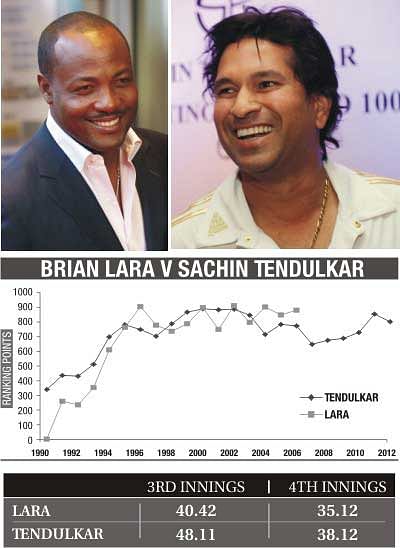Lara or Tendulkar?

On the week of Brian Lara's hallowed 375 and one week to Sachin Tendulkar's birthday, the Daily Star's Shafin Majid examines an endless debate; who is the best of them all?
Brian Lara scored 375 and 400*, Sachin Tendulkar has scored over 50 centuries. To date, Tendulkar averages 55.44, Lara averaged 52.88. Debates as to who is the greater Test batsman have never completely died out. Who is greater Lara or Tendulkar?
Tallying each player's strengths and concluding the one with more is the greater player would be like counting the teeth of the two most dangerous lions in the world and concluding the one with more is more dangerous to deer. Both have more than enough strengths for the business of scoring runs aplenty. More interesting weaknesses. From this perspective, Tendulkar comes out ahead.
Lara had difficulties against fast bowling. He never scored a Test hundred against the outstanding fast men of his time Wasim Akram, Waqar Younis or Allan Donald and never looked likely to. In 1997/98 on the flat wickets of Pakistan he failed to reach 50 in 6 completed innings. His high back lift made it difficult for him just to get the bat down in time to meet the ball the fast ball.
The short pitched ball also caused Lara much grief and the bowler did not even have to be off the highest pace to ruffle those princely Trinidadian feathers Lara jerking his head out of the ball's way at the last second or desperately fending off rising deliveries was a common sight, and it also led to his dismissal often enough to be called a genuine (as opposed to purely aesthetic) weakness.
The high back lift also contributed to Lara's difficulties on worn wickets.
In later stages of the match, the ball's bounce and pace become less regular, and the high back lift made it difficult for Lara to adjust to anything unexpected off the wicket.
Lara's celebrated footwork that looked so pleasing brought with it a fair share of troubles as well. By going so far across, he left his leg stump exposed and increased the chances of a glanced catch to the keeper, as well as being bowled behind his legs. Furthermore, it obliged him to play at balls wide of the off stump that most batsmen would leave. Also apparent was a disinclination to come forward to the pitched up ball. Lara's bat-work in defence was less than ideal. A typical Lara defensive shot sent the ball to point or even backward point (by contrast Tendulkar's more solid effort tended to go to cover or mid off).
A combination of poor judgement outside the off stump, not coming forward, and soft bat-work in defence led to Glenn McGrath regularly dismissing the West Indian by doing little more than putting the ball in the right area. Tendulkar, by contrast, has never had a particular 'bogey' bowler.
Tendulkar has had far fewer exploitable chinks in his armour. Occasionally, he gets in the temporary habit of missing angled bat strokes to straight balls, and thus leaves himself open to an LBW dismissal. Recently, the sweep shot to straight balls has put him in a similar position. For the most part however, Tendulkar is able to adjust his game if his approach is not working. In Australia in 2004/05, he cut out the off-side shots that were giving him trouble for 3 matches, and proceeded to score 300 runs in the last match without being dismissed.
There are of course, areas where Lara is Tendulkar's superior, but the essential point is that Tendulkar has far fewer genuine weaknesses. For example, Lara played spin bowling better than Tendulkar, but nobody in their right mind would claim that the Indian had a “weakness” against spin. By contrast, Tendulkar played fast bowling better than Lara, who had a legitimate weakness against express pace.
Some rate Lara higher on what we might call the “glamour” factor. He was a faster scorer and a more thrilling player to watch than Tendulkar. Such judges tend to suggest that the weakness of Lara's team mates make his achievements greater than Tendulkar's and they site his ability to play his best in pressure situations.
How much weight one chooses to give such romantic notions is purely a personal choice. Saving a game by playing solidly is at least as important as the ability to tear into an attack in the test arena. Tendulkar is undoubtedly ahead in the former category, while Lara claims the top spot in the latter. The only-class-player-in-a-weak-team argument is at best a two edged sword: Ted Dexter has noted that in such situations, the bowling side usually focus their efforts on dismissing the weaker batsmen, thus actually making it easier for the one class player to score runs. The claim that Lara single-handedly won matches for his team and played well in pressure situations is a starry-eyed view usually based mainly on (understandably) sentimental recollections of Lara's mind-bending innings of 153*. One innings, however great, out of 232, does not make a clutch player. The more practical facts of the matter show that Lara averages 61.02 in wins, to Tendulkar's 66.59.
That Lara and Tendulkar are both great players is indisputable. The difference in quality between the two is infinitesimal. One could put Lara in Tendulkar's place in a team, or vice-versa, and there would probably be no change in the team's results. From the perspective of weaknesses and given that the strengths of the two players can be taken for granted, however, Tendulkar comes out comfortably ahead of the West Indian champion.

 For all latest news, follow The Daily Star's Google News channel.
For all latest news, follow The Daily Star's Google News channel. 



Comments